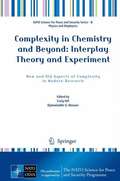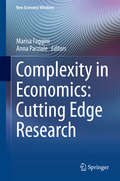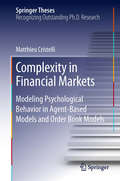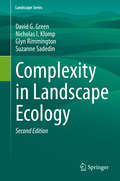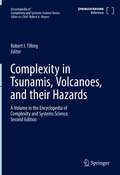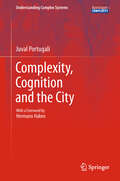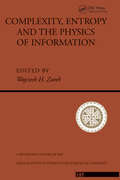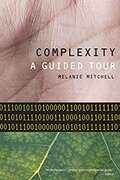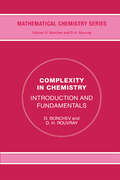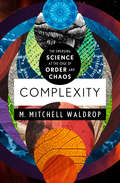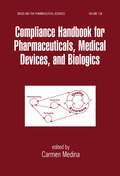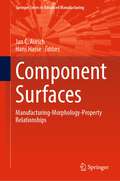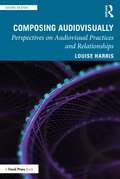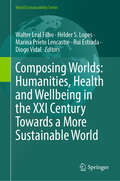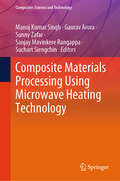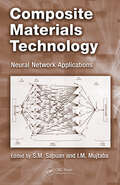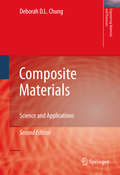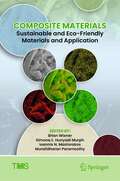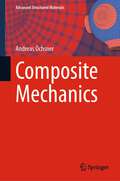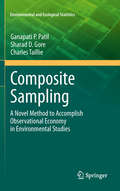- Table View
- List View
Complexity and the Arrow of Time
by Michael Ruse Charles H. Lineweaver Paul C. W. Davies Charles H. Lineweaver Paul C. W. DaviesThere is a widespread assumption that the universe in general, and life in particular, is 'getting more complex with time'. This book brings together a wide range of experts in science, philosophy and theology and unveils their joint effort in exploring this idea. They confront essential problems behind the theory of complexity and the role of life within it: what is complexity? When does it increase, and why? Is the universe evolving towards states of ever greater complexity and diversity? If so, what is the source of this universal enrichment? This book addresses those difficult questions, and offers a unique cross-disciplinary perspective on some of the most profound issues at the heart of science and philosophy. Readers will gain insights in complexity that reach deep into key areas of physics, biology, complexity science, philosophy and religion.
Complexity in Chemistry and Beyond: New and Old Aspects of Complexity in Modern Research (NATO Science for Peace and Security Series B: Physics and Biophysics)
by Craig Hill Djamaladdin G. MusaevComplexity occurs in biological and synthetic systems alike. This general phenomenon has been addressed in recent publications by investigators in disciplines ranging from chemistry and biology to psychology and philosophy. Studies of complexity for molecular scientists have focussed on breaking symmetry, dissipative processes, and emergence. Investigators in the social and medical sciences have focused on neurophenomenology, cognitive approaches and self-consciousness. Complexity in both structure and function is inherent in many scientific disciplines of current significance and also in technologies of current importance that are rapidly evolving to address global societal needs. Several of these multifaceted scientific disciplines are addressed in this book including complexity from the general and philosophical perspective, magnetic phenomena, control of self assembly and function in large multicomponent clusters, application of theory to probe structure and mechanism in highly complex molecular species, and the design of multifunctional nanoscale molecules of value in decontamination and solar fuels research. Each chapter is both a review and addresses some ongoing challenges, thus each should provide a good preparation for further work in these highly active areas of research endeavour.
Complexity in Economics: Cutting Edge Research (New Economic Windows)
by Marisa Faggini Anna ParzialeIn this book, leading experts discuss innovative components of complexity theory and chaos theory in economics. The underlying perspective is that investigations of economic phenomena should view these phenomena not as deterministic, predictable and mechanistic but rather as process dependent, organic and always evolving. The aim is to highlight the exciting potential of this approach in economics and its ability to overcome the limitations of past research and offer important new insights. The book offers a stimulating mix of theory, examples and policy. By casting light on a variety of topics in the field, it will provide an ideal platform for researchers wishing to deepen their understanding and identify areas for further investigation.
Complexity in Financial Markets: Modeling Psychological Behavior in Agent-Based Models and Order Book Models (Springer Theses)
by Matthieu CristelliTools and methods from complex systems science can have a considerable impact on the way in which the quantitative assessment of economic and financial issues is approached, as discussed in this thesis. First it is shown that the self-organization of financial markets is a crucial factor in the understanding of their dynamics. In fact, using an agent-based approach, it is argued that financial markets' stylized facts appear only in the self-organized state. Secondly, the thesis points out the potential of so-called big data science for financial market modeling, investigating how web-driven data can yield a picture of market activities: it has been found that web query volumes anticipate trade volumes. As a third achievement, the metrics developed here for country competitiveness and product complexity is groundbreaking in comparison to mainstream theories of economic growth and technological development. A key element in assessing the intangible variables determining the success of countries in the present globalized economy is represented by the diversification of the productive basket of countries. The comparison between the level of complexity of a country's productive system and economic indicators such as the GDP per capita discloses its hidden growth potential.
Complexity in Landscape Ecology (Landscape Series #22)
by David G. Green Nicholas I. Klomp Glyn Rimmington Suzanne SadedinThis book examines key concepts and analytical approaches in complexity theory as it applies to landscape ecology, including complex networks, connectivity, criticality, feedback, and self-organisation. It then reviews the ways that these ideas have led to new insights into the nature of ecosystems and the role of processes in landscapes. The updated edition explores innovations in ecotechnology, including automated monitoring, big data, simulation and machine learning, and shows how they are revolutionizing ecology by making it possible to deal more effectively with complexity. Addressing the topic in a progression of ideas from small to large, and from simple to sophisticated, the book examines the implications of complexity for major environmental issues of our time, particularly the urgencies of climate change and loss of biodiversity. Understanding ecological complexity is crucial in today’s globalized and interconnected world. Successful management of the world’s ecosystems must combine models of ecosystem complexity with biodiversity, environmental, geographic, and socioeconomic data. The book examines the impact of humans on landscapes and ecosystems, as well as efforts to embed sustainability, commerce and industrial development in the larger context of ecosystem services and ecological economics. Well-established as researchers in the field, the authors provide a new perspective on current and future understanding of complexity in landscape ecology. The new edition offers a non-technical account of the topic, so it is both accessible and informative for general readers. For students of ecology, it provides a fresh approach to classical ideas.
Complexity in Tsunamis, Volcanoes, and their Hazards (Encyclopedia of Complexity and Systems Science Series)
by Robert I. TillingThis volume of the Encyclopedia of Complexity and Systems Science, Second Edition is an authoritative single source for understanding and applying the basic tenets of complexity and systems theory, as well as the tools and measures for analyzing complex systems, to the prediction, monitoring, and evaluation of earthquakes, tsunamis, and volcanoes. Early warning, damage, and the immediate response of human populations to these extreme environmental events are also covered from the point of view of complexity and nonlinear systems. In authoritative, state-of-the art articles, world experts in each field apply such complexity tools and concepts as fractals, cellular automata, solitons game theory, network theory, and statistical physics to an understanding of these complex geophysical phenomena.
Complexity, Cognition and the City: Simulation, Cognition And Vr In The Study And Planning Of Cities (Understanding Complex Systems)
by Juval PortugaliComplexity, Cognition and the City aims at a deeper understanding of urbanism, while invoking, on an equal footing, the contributions both the hard and soft sciences have made, and are still making, when grappling with the many issues and facets of regional planning and dynamics. In this work, the author goes beyond merely seeing the city as a self-organized, emerging pattern of some collective interaction between many stylized urban "agents" - he makes the crucial step of attributing cognition to his agents and thus raises, for the first time, the question on how to deal with a complex system composed of many interacting complex agents in clearly defined settings. Accordingly, the author eventually addresses issues of practical relevance for urban planners and decision makers. The book unfolds its message in a largely nontechnical manner, so as to provide a broad interdisciplinary readership with insights, ideas, and other stimuli to encourage further research - with the twofold aim of further pushing back the boundaries of complexity science and emphasizing the all-important interrelation of hard and soft sciences in recognizing the cognitive sciences as another necessary ingredient for meaningful urban studies.
Complexity, Entropy And The Physics Of Information (Santa Fe Institute Ser)
by Wojciech H. ZurekA must have for those with a deep commitment to the second law of thermodynamics, entropy, and information theory.
Complexity: A Guided Tour
by Melanie MitchellWhat enables individually simple insects like ants to act with such precision and purpose as a group? How do trillions of neurons produce something as extraordinarily complex as consciousness? In this remarkably clear and companionable book, leading complex systems scientist Melanie Mitchell provides an intimate tour of the sciences of complexity, a broad set of efforts that seek to explain how large-scale complex, organized, and adaptive behavior can emerge from simple interactions among myriad individuals. Based on her work at the Santa Fe Institute and drawing on its interdisciplinary strategies, Mitchell brings clarity to the workings of complexity across a broad range of biological, technological, and social phenomena, seeking out the general principles or laws that apply to all of them. <p><p>Richly illustrated, Complexity: A Guided Tour--winner of the 2010 Phi Beta Kappa Book Award in Science--offers a wide-ranging overview of the ideas underlying complex systems science, the current research at the forefront of this field, and the prospects for its contribution to solving some of the most important scientific questions of our time.
Complexity: Introduction and Fundamentals
by Danail Bonchev Dennis H. RouvrayThis volume covers the rapidly developing field of complexity studies with the underlying theme that complexity is to be found everywhere. The volume discusses many chemical applications and offers a comprehensive coverage of complexity and the ways in which it may be measured, complexity indices, complexity measures based on Shannon's information
Complexity: The Emerging Science at the Edge of Order and Chaos
by M. Mitchell WaldropWhy did the stock market crash more than 500 points on a single Monday in 1987? Why do ancient species often remain stable in the fossil record for millions of years and then suddenly disappear? In a world where nice guys often finish last, why do humans value trust and cooperation? At first glance these questions don't appear to have anything in common, but in fact every one of these statements refers to a complex system. The science of complexity studies how single elements, such as a species or a stock, spontaneously organize into complicated structures like ecosystems and economies; stars become galaxies, and snowflakes avalanches almost as if these systems were obeying a hidden yearning for order.
Complexity: The Emerging Science at the Edge of Order and Chaos
by M. Mitchell Waldrop&“If you liked Chaos, you&’ll love Complexity. Waldrop creates the most exciting intellectual adventure story of the year&” (The Washington Post). In a rarified world of scientific research, a revolution has been brewing. Its activists are not anarchists, but rather Nobel Laureates in physics and economics and pony-tailed graduates, mathematicians, and computer scientists from all over the world. They have formed an iconoclastic think-tank and their radical idea is to create a new science: complexity. They want to know how a primordial soup of simple molecules managed to turn itself into the first living cell—and what the origin of life some four billion years ago can tell us about the process of technological innovation today. This book is their story—the story of how they have tried to forge what they like to call the science of the twenty-first century. &“Lucidly shows physicists, biologists, computer scientists and economists swapping metaphors and reveling in the sense that epochal discoveries are just around the corner . . . [Waldrop] has a special talent for relaying the exhilaration of moments of intellectual insight.&” —The New York Times Book Review &“Where I enjoyed the book was when it dove into the actual question of complexity, talking about complex systems in economics, biology, genetics, computer modeling, and so on. Snippets of rare beauty here and there almost took your breath away.&” —Medium &“[Waldrop] provides a good grounding of what may indeed be the first flowering of a new science.&” —Publishers Weekly
Compliance Handbook for Pharmaceuticals, Medical Devices, and Biologics (Drugs And The Pharmaceutical Sciences Ser. #Vol. 136)
by Carmen MedinaThis text lists the necessary steps for meeting compliance requirements during the drug development process. It presents comprehensive approaches for validating analytical methods for pharmaceutical applications.
Compliance or Defiance?: Assessing the Implementation of Policy Prescriptions for Commercialization by Water Operators (IHE Delft PhD Thesis Series)
by Mireia TutusausWhereas the global water community may have reached consensus on the need for water providers to operate on the basis of commercial principles, staff of water utilities are faced with the challenge of implementing these principles in their everyday work. In the everyday domain, these principles appear to directly conflict with the mandate of water operators to provide water services to all. Moreover, the socio-political, economic and bio-physical context in which these water operate may be ill-suited to implement commercialization. In pursuing commercialization these operators adapt, reinterpret, modify, deflect, alter or betray the original principles of commercialization during implementation. This research takes inspiration from the rich literature on policy implementation and policy translation, which argues that policy models need to be transformed and modified if they are to be successfully adopted or implemented. This research analyzes the alterations visible in the daily implementation of commercial models of water provisioning and, in doing so, present a better understanding of how water operators implement policy prescriptions of commercialization in practice. Based on the analysis of the adaptations and (re)interpretations of the implemented model of commercialization in the different cases, this thesis argues that a new way of speaking about commercialization should be developed.
Complications and Outcomes of Assisted Reproduction
by Botros Rizk Jan GerrisApproximately five million children have been born worldwide as a result of assisted reproductive technology (ART). These techniques are now practised independently in most of the world's nations. Although the vast majority of ART parents and children are healthy following the procedures involved, there is an imperative to maintain a high standard of practice and monitor outcomes carefully. Interpretation of outcome data is difficult for a variety of reasons. As ART technologies evolve and new variants are established, the need for robust assessment of outcomes increases. This book gives a thorough review of potential complications of ART, with detailed analysis of outcome data for the various conditions described. A worldwide perspective is given throughout, with an international team of chapter authors.
Complications: A Surgeon's Notes on an Imperfect Science
by Atul GawandeA surgeon writes about some of his most interesting patients.
Component Surfaces: Manufacturing-Morphology-Property Relationships (Springer Series in Advanced Manufacturing)
by Jan C. Aurich Hans HasseThis book sheds new light on component surfaces and the scientific fundamentals of their creation, characterization, and application. The book also provides a new interdisciplinary perspective on the topic, studying component surfaces with a multiscale approach and linking fundamental and applied research. The book builds on the success of the coordinated research project funded by Deutsche Forschungsgemeinschaft (DFG) from 2011 – 2023: the CollaborativeResearch Center CRC 926 “Microscale Morphology of Component Surfaces (MI-COS)”, in which, over the years, 100+ researchers have co-operated at the University of Kaiserslautern, Germany, and affiliated institutes, yielding 500+ scientific papers in journals from different fields of science and engineering. Divided into 2 main parts, the book starts with an introduction to the concept of Manufacturing-Morphology-Property (MMP) Relationships and dives into the fundamentals and technologies, including topics such as the geometrical, microstructural, and chemical characterization, indentation, and scratching on the nanoscale, micro milling and micro grinding, cryogenic machining, cold spraying, and additive manufacturing. In the first part, readers discover more about the interactions between particles and surfaces, the interrelationship of manufacturing, surface morphology and properties of titanium, the influence of manufacturing and load conditions on the phase transformation and fatigue of austenitic stainless steels, and the influence of surface morphology on fatigue and tribological behavior of Transformation-Induced-Plasticity (TRIP)/Twinning-Induced Plasticity (TWIP) Steels. The second part of this book is devoted to the applications of component surfaces, covering topics like the manufacturing of areal material measures, MMP relationships for rotating shaft sealing systems, the influence of the surface morphology on rolling bearing life under mixed lubrication, MMP relationships for chain joints, and MMP for biofilms. Scientists and engineers who deal with the influence of surfaces on macroscopic properties of components and who are interested in designing and manufacturing these surfaces to obtain desired component properties will understand the appeal of this work. Given its interdisciplinary breadth, the book also appeals to scholars and professionals in the fields of mechanical engineering, process engineering, and physics.
Composing Audiovisually: Perspectives on audiovisual practices and relationships (Sound Design)
by Louise HarrisWhat does the Coen Brothers’ Barton Fink have in common with Norman McLaren’s Synchromy? Or with audiovisual sculpture? Or contemporary music video? Composing Audiovisually interrogates how the relationship between the audiovisual media in these works, and our interaction with them, might allow us to develop mechanisms for talking about and understanding our experience of audiovisual media across a broad range of modes. Presenting close readings of audiovisual artefacts, conversations with artists, consideration of contemporary pedagogy and a detailed conceptual and theoretical framework that considers the nature of contemporary audiovisual experience, this book attempts to address gaps in our discourse on audiovisual modes, and offer possible starting points for future, genuinely transdisciplinary thinking in the field.
Composing Worlds: Humanities, Health and Wellbeing in the XXI Century Towards a More Sustainable World (World Sustainability Series)
by Walter Leal Filho Hélder S. Lopes Marina Prieto Lencastre Rui Estrada Diogo VidalThis book provides an interdisciplinary exploration of how the humanities, social sciences, and health sciences can contribute to addressing the pressing challenges of the Anthropocene. From climate change and biodiversity loss to environmental degradation and public health threats, the book examines the interconnected crises of our time and offers innovative frameworks for fostering sustainability, resilience, and equity. It highlights the cultural, ethical, and philosophical dimensions of these issues to underscore the importance of collaboration across disciplines to shape a just and sustainable future. Key topics include the role of art, literature, and philosophy in raising environmental awareness, the impact of urban green spaces on social participation and health, and the integration of mental health into sustainability discussions. The book also explores eco-anxiety, digital technologies, and citizen science as pivotal aspects of contemporary socio-environmental challenges. Through case studies and theoretical insights, it demonstrates the value of combining scientific expertise with cultural and ethical understanding to create effective solutions for global and local problems. This book is a valuable resource for researchers, students, policymakers, and practitioners in the humanities, social sciences, health, and environmental studies. It invites readers to rethink their relationship with nature and society while inspiring transformative actions that prioritize sustainability and equity. Whether addressing global crises or local community initiatives, this work offers practical insights and fresh perspectives for anyone committed to building a healthier, more sustainable future.
Composite Materials Processing Using Microwave Heating Technology (Composites Science and Technology)
by Suchart Siengchin Gaurav Arora Sanjay Mavinkere Rangappa Manoj Kumar Singh Sunny ZafarThis book covers all aspects of composite materials processing and manufacturing using microwave heating technology and their applications in various industrial processes. Depending in the processing and material used, the composites are divided into three major segments: Metal matrix composites (MMCS), ceramics composites (CMCS), and polymer matrix composites (PMCS), respectively. During the manufacturing process of these composite materials, conventional heating technologies are used in which the heat is transferred from the electrical resistance coils to the material via conventional modes of heat transfer. Issues like non-uniform temperature distribution, poor curing efficiency, generation of the in-process scrap, long process cycle, high energy consumption and cost make traditional manufacturing route a difficult choice to select. Recently, microwave-assisted heating has emerged as a promising route for the fabrication of composites as a cost-effective environmentally sustainablemanufacturing process that yields improved mechanical properties which is the main topic of this book. It looks into the mechanism, salient features, and important aspects of microwave heating and their interaction with different composites materials. It also presents other manufacturing processes of various composites using microwave heating during casting, drilling, recycling, sintering, material joining, surface engineering. This book will appeal to students, researchers and scientists working in the area of composite materials processing and manufacturing.
Composite Materials Technology: Neural Network Applications
by S. M. Sapuan I. M. MujtabaArtificial neural networks (ANN) can provide new insight into the study of composite materials and can normally be combined with other artificial intelligence tools such as expert system, genetic algorithm, and fuzzy logic. Because research on this field is very new, there is only a limited amount of published literature on the subject.Compiling in
Composite Materials: Science and Applications (Engineering Materials and Processes)
by Deborah D. ChungThe first edition of "Composite Materials" introduced a new way of looking at composite materials: covering composites in accordance with their functions. This second edition expands the book's scope to emphasize application-driven and process-oriented materials development. This tutorial-style reference book examines both structural composite materials and functional composite materials, as needed for a substantial range of applications. The emphasis on application-driven and process-oriented materials development is enhanced by a large amount of experimental results that provide real illustrations of composite materials development. "Composite Materials" is an essential book for researchers and engineers who are interested in materials development for industrial applications. It has a vibrant yet functional approach, making it suitable for both students and practitioners, and provides a full explanation of all of the fundamental concepts related to the structural and functional properties covered.
Composite Materials: Sustainable and Eco-Friendly Materials and Application (The Minerals, Metals & Materials Series)
by Simona E. Hunyadi Murph Brian Wisner Ioannis N. Mastorakos Muralidharan ParamsothyThis collection covers innovations in the field of composite materials with a specific focus on eco-friendly and environmentally sustainable systems. All composite fields are explored, including polymer, metal, and ceramic matrix composites with an emphasis on sourcing raw materials in a sustainable way as well as the development of composite materials for environmental sustainability. Topics will include the development of new materials for structural applications, reduction in energy consumption, and increased component life along with discussions of novel methods to reuse existing materials. Additional topics include, but are not limited to:· Naturally Sourced Materials feedstock · Recycled Material feedstock, · Application of composite for reduced carbon footprint · Development of novel materials to repurpose waste from other areas
Composite Mechanics (Advanced Structured Materials #184)
by Andreas ÖchsnerThis book in the advanced structured materials series provides first an introduction to the mircomechanics of fiber-reinforced laminae, which deals with the prediction of the macroscopic mechanical lamina properties based on the mechanical properties of the constituents, i.e., fibers and matrix. Composite materials, especially fiber-reinforced composites, are gaining increasing importance since they can overcome the limits of many structures based on classical metals. Particularly, the combination of a matrix with fibers provides far better properties than the constituents alone. Despite their importance, many engineering degree programs do not treat the mechanical behavior of this class of advanced structured materials in detail, at least on the bachelor’s degree level. Thus, some engineers are not able to thoroughly apply and introduce these modern engineering materials in their design process. The second part of this book provides a systematic and thorough introduction to the classical laminate theory based on the theory for plane elasticity elements and classical (shear-rigid) plate elements. The focus is on unidirectional lamina which can be described based on orthotropic constitutive equations and their composition to layered laminates. In addition to the elastic behavior, failure is investigated based on the maximum stress, maximum strain, Tsai-Hill, and the Tsai-Wu criteria. The introduced classical laminate theory provides a simplified stress analysis, and a subsequent failure analysis, without the solution of the system of coupled differential equations for the unknown displacements in the three coordinate directions. The book concludes with a short introduction to a calculation program, the so-called Composite Laminate Analysis Tool (CLAT), which allows the application of the classical laminate based on a sophisticated Python script.
Composite Sampling: A Novel Method to Accomplish Observational Economy in Environmental Studies (Environmental and Ecological Statistics #4)
by Sharad D. Gore Ganapati P. Patil Charles TaillieSampling consists of selection, acquisition, and quantification of a part of the population. While selection and acquisition apply to physical sampling units of the population, quantification pertains only to the variable of interest, which is a particular characteristic of the sampling units. A sampling procedure is expected to provide a sample that is representative with respect to some specified criteria. Composite sampling, under idealized conditions, incurs no loss of information for estimating the population means. But an important limitation to the method has been the loss of information on individual sample values, such as, the extremely large value. In many of the situations where individual sample values are of interest or concern, composite sampling methods can be suitably modified to retrieve the information on individual sample values that may be lost due to compositing. This book presents statistical solutions to issues that arise in the context of applications of composite sampling.

